Why is having engaged employees so important? It’s one of the biggest advantages your company can have. Our jobs and careers are major parts in our lives. People want to feel enthusiastic, passionate and happy when they go to work. So how can you make sure you have engaged employees?
Employee engagement surveys are a good start to see how your employees feel. Surveys are a tried and tested method for understanding how engaged employees feel. Not sure where to start and want to make sure you’re getting it right? In this blog post we’ll be taking you a 2021 guide to employee engagement surveys which will cover:
- What is employee engagement?
- Key employee engagement statistics
- Why measure employee engagement?
- What is an employee engagement survey?
- Employee engagement surveys vs pulse surveys
- What is the purpose of an employee engagement survey?
- Why employee engagement surveys are important
- Do employee engagement surveys work?
- How to conduct an employee engagement survey
- Sample Employee engagement survey questions
What Is Employee Engagement?
Employee engagement affects numerous areas of your company. From customer experience to employee turnover to revenue, engagement impacts it all. Employee engagement is the connection employees feel towards their work. It measures how employees feel - mentally and emotionally - about their organisation.
Engaged employees can transform your business. Employees can be categorized by engagement into four main groups:
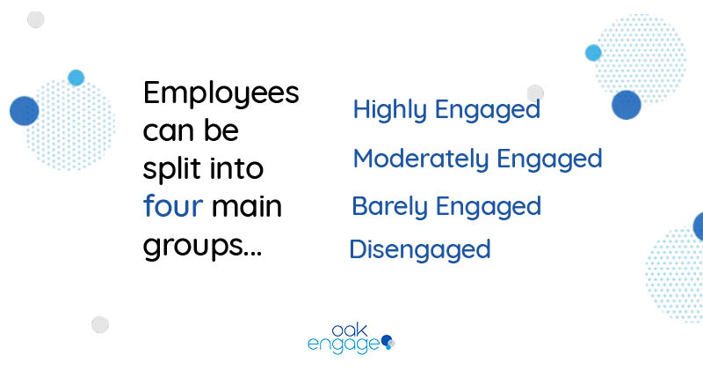
Highly Engaged: Employees are advocates of the company and connected to their team. They're likely to stay with the organisation long term.
Moderately Engaged: Employees enjoy their job, but certain elements hold them back. They can see opportunities for improvement and may be prone to underperforming.
Barely Engaged: Employees aren't engaged and at risk of leaving. There is a lack of motivation in their role and they do as much as they can to get by. These employees will be researching other jobs.
Disengaged: Disengaged employees are negative and disruptive. There is no connection between the employee and the organisation. There is a large lack of commitment.
Ideally, employees should be highly or moderately engaged. Engaged employees are productive and have a big connection to their organisation. They work hard. Barely and disengaged employees limit the potential of both your team and business as a whole.
Recommended Reading 📖 Employee Engagement ROI [FREE Calculator]
Key Employee Engagement Statistics
How exactly does having disengaged employees affect your business? These employee engagement statistics show the effects of having disengaged employees:
- Disengaged employees are less likely to work hard and meet expectations. They cause 60% more errors and defects in work performance. Errors and mistakes can lead to poor team performance and longer completion times. Ultimately, it can negatively impact how people view your brand.
- Disengaged employees cost the UK £52 - 70 billion per year in lost productivity. Scarily, one of the most negative figures in Western Europe.
- Gallup's state of the global workplace 85% of the global workforce are not engaged at work. Employees across the world are viewing their workplace in a negative light. There is a lack of attachment to their jobs.
- Lack of engagement is especially concerning in the UK. Only 17% of employees are engaged or emotionally invested in their organisation. That’s 83% of the UK workforce that are disengaged.
- Creating a culture where employees are engaged creates an environment for retention. Employees who find passion and purpose at work are more than 3x likely to stay than those who don’t.
Interested in learning more? We’ve got a roundup of 25 employee engagement statistics that you wouldn’t believe.
Why Measure Employee Engagement?
It’s important to measure employee engagement and make changes based on feedback. Discover where your employees currently stand with regards to employee engagement. Then you can adapt and improve areas of the business if needed. Measuring employee engagement brings a whole host of benefits:
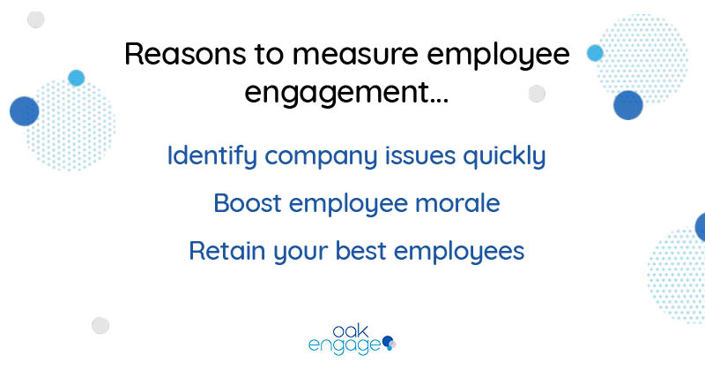
- You’ll be able to identify issues quicker: Feedback helps identify problems. The quicker you find problems means you can identify opportunities for improvement. You'll then identify the right solutions to go with them
- You’ll boost morale within the company: Employees want to be part of company growth. The chance to provide feedback indicates that you value their opinion and needs.
- You’ll keep your best employees: It can take a while to find the right employee, the person who fits the job perfectly. It can be almost as difficult to keep those employees. Individuals with drive and ambition want to work somewhere exciting. Employees want to feel appreciated. When your top employees are engaged, it has a huge impact on the business.
Taking action from employee feedback creates a positive workforce. Knowing their voices are heard results in a productive and valued workforce. Benefits will be seen across all areas of the business.
Recommended Reading 📖 Why Is Employee Engagement Important? [Key Benefits]
What is an Employee Engagement Survey?
Engagement surveys provide a yearly overview of engagement within your workplace. They’re usually sent out annually or bi-annualy. Surveys help you identify and solve problems within your business. They're a great tool to regularly discover areas of the business that need improving.
The surveys consist of around 30-60 questions that cover a range of topics. Staff engagement surveys have more questions, so they can take longer to complete. It’s vital to reiterate the importance of the survey to your employees and ensure you take action from them.
A well designed employee engagement survey will reveal measurable information about your workforce. The findings can be used to improve employee engagement. Staff engagement surveys mean you can analyse how engaged employees are. With the data you can analyse the why, and make improvements.
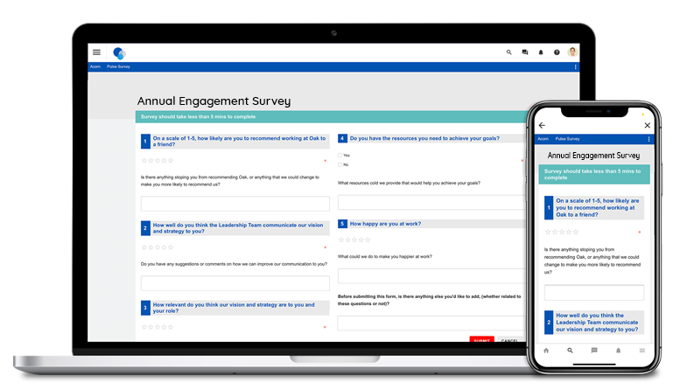
Employee Engagement Surveys vs Pulse Surveys
Employee engagement surveys and pulse surveys are both great feedback tools. But in what ways do they differ?
Engagement Surveys:
- Provide an annual or bi-annual snapshot of your workplace
- Contain more questions (usually around 30-60)
- Focus on a variety of topics
- Take more time to complete
Pulse surveys are:
- Shorter and more frequent than engagement surveys. They’re usually conducted weekly, monthly or quarterly.
- Quick to complete
- Range from anywhere from 5 - 30 questions, depending on the frequency they’re sent out
- Conducted on a more regular basis and help gain quicker, relevant feedback
- Normally focus on a specific issue or question
Employee engagement is a big focus for HR professionals and so employee engagement surveys and pulse surveys are great tools that compliment one another. Used together properly, you can gather vital data that can result in beneficial changes for your workforce.
What is the Purpose of an Employee Engagement Survey?
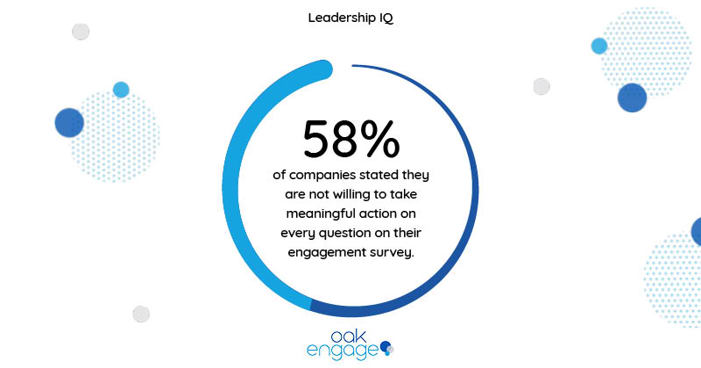
In Leadership IQs survey “How good is your employee engagement survey?” only 42% of companies stated that they are 100% willing to take action on every single question on our survey. That's a shocking 58% of companies who are not taking meaningful action from engagement surveys. So what is the purpose of an engagement survey:
- They give your employees a place to submit open, honest and anonymous feedback
- You can analyse the results and work out what areas of the business need to be improved. Or what needs to remain the same.
- You can take action from the feedback and implement changes within your organisation
Conducting an engagement survey means you have the right information to impact employee engagement. Results make it easy to identify problem areas within the organisation . With the results, take action. Show your employees that their views impact how the organisation grows and adapts.
Why Employee Engagement Surveys Are Important
Engagement surveys show the commitment your company has towards engagement. It shows you're willing to adapt and improve the business. It has a big impact on your employees capabilities and potential. It's important to show you listen and act on your employees' words. You’ll reap a whole bunch of benefits:
- Engaged employees are profitable employees. Highly engaged employees result in a 23% increase in profitability.
- Employees are motivated by effective internal communications. 85% of employees as found by Trade Press Research . Making sure your employees are aware of company goals and challenges is key. As well, having a clear definition of their role leads to motivation and engagement.
- Do you know what's driving disengagement within your business? Only 22% of companies actually know according to The Predictive Index. Engagement surveys and having an employee engagement strategy in place is vital.
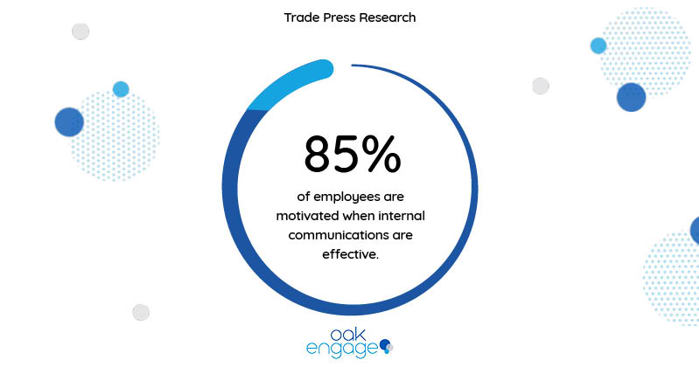
Do Employee Engagement Surveys Work?
89% of HR Leaders believe that ongoing employee feedback surveys and check ins are key for successful outcomes. Employee engagement should be part of a company's overall business strategy.
Having regular employee engagement surveys results in high performance practices. But why?
- Surveys can be indicators of your employees behaviour: Want answers? No one can answer questions better than your own workforce. Results will help you interpret behaviour and make decisions based on your findings.
- They make employees feel heard: Listening is important. By not conducting a survey it shows a lack of consideration to your employees. Surveys act as a specific channel for expressing their views and thoughts. Employees that feel heard are 4.6 times more likely to feel empowered and perform their best work.
- They’re a tool to change behaviour: Send out surveys consistently. Employees will know when to expect them and people will make a commitment to fill them out. Knowing that this is their chance to have their voice heard means they'll answer honestly. They'll know that what they say does have an impact. You can then monitor any changes and progress and make changes as you go along.
Employee engagement surveys are all about taking action. Done correctly employee engagement surveys can be a transformative tool for your business. Don't spend time curating and conducting engagement surveys for it to be left answered. For an employee engagement survey to work, be useful and have a high response rate, it must be designed well.
Once designed, planned and distributed it’s essential to have an action plan on what you’ll do with the results. You'll be able to focus on specific areas to improve employee engagement. Once you’ve identified changes that need to be made, set priorities. Make a plan and determine how you'll implement and communicate changes.
How to Conduct an Employee Engagement Survey

There are a number of steps you can take to create a successful employee engagement survey:
Design your survey properly: Think carefully about what you want to get from your survey and how the results will be used. Decide on the purpose of your survey and use this to inform the kind of questions you want to ask. You need to make sure any questions you ask are direct, unambiguous and worded neutrally.
Each question is an opportunity to improve areas of your business. The survey means that employees have a say in improvement. It shows the company is constantly developing and improving opportunities for employees.
Ensure you use a mixture of questions: Use a combination of open and closed questions in your survey to get the most out of your data. Closed questions provide quantitative information. Turn data into statistics to identify trends. Open questions give employees the chance to speak in their own words. This means useful and insightful feedback.
Encourage participation: Try to get the majority of staff to complete the survey. This will mean an accurate overview of employee engagement in the business. Reiterate the importance and that completing the survey means you can make improvements.
Give employees enough time to complete the survey, two weeks should be more than enough time.
Ensure anonymity:One of the most important things to consider with surveys is anonymity. Employees need to be able to provide their honest thoughts and opinions. Making sure their answers are anonymous is key.
Consider people’s demographics in the design of the survey. If there is only one female member in a team, this individual will be easily identifiable. Consider how you will keep employees anonymous throughout.
Review the results: Once all the results are in, it’s time to analyse! You’ll get a picture of any clear trends or patterns affecting the company or even particular teams. You can begin to decide where to go from here.
Communicate the results: Surveys are a two way communication channel so once you have the results, share them. Employees will want to see if others share their views and how their answers add to the bigger picture.
Create an action plan: You’ve got the results and now you need to take action. Taking action from the results shows your employees that this isn’t just a tick in the box procedure. It tells them that you’re here to listen to what they say and make changes based on that. What steps can you take to make improvements using the results you have?
Decide how you’ll monitor the changes: When implementing a new strategy, have a method of keeping track of the impact and if it’s successful or not. You could use monthly pulse surveys to see if any of the new initiatives you’ve proposed are successful.
Sample Employee Engagement Survey Questions
Need some inspiration for questions to include in your survey? Here’s a selection of questions relating to certain topics to ask your employees…
Satisfaction/Engagement Questions
Are your employees satisfied with their job? Having satisfied employees means having engaged employees. Ask these questions to discover if there are any underlying issues or problems:
- On a scale of 1-10 how happy are you at work?
- Would you tell your friends that [company name] is a great place to work?Do you have a clear understanding of your career path?
- On a scale of 1-10 how would you rate the work life balance?
- If you were to leave your current role, what would be the reasons?
- Are you satisfied with the benefits and perks [company name] provide?
Culture & Belonging
There’s a strong link between a good company culture and engagement levels. Explore how people feel about the company culture with these questions:
- How comfortable do you feel providing feedback to your manager?
- Does management contribute to a positive work culture?
- What three words would you use to describe [company name] culture?
- Do you find [company name] a good place to work?
- Do co-workers have respect and trust for one another?
- Do your values align with the company values?
Management
Good leadership is vital to engaging your workforce and there’s no one better to ask than the people who you lead. Gather how well employees view leadership with these questions:
- Do you feel valued at work?
- Do you receive enough recognition from your manager?
- When you last completed a big project, did you receive any praise?
- Does management communicate performance expectations clearly?
- Does your manager communicate changes to company policies or benefits?
- When company decisions are made, do management explain the reasons behind this?
Personal Growth
Support employees with their own personal growth. It gives them confidence, boosts morale and gives them goals to work towards. Having goals and milestones encourages engagement. It allows employees to show passion and enthusiasm towards achieving their goals. Need sample questions for seeing how your employees feel about their personal growth? Here's a few:
- I can see myself growing and developing my career with [company name]
- [Company name] supports me in my skill development
- I am inspired to do my best when it comes to job performance
- Are there any new projects you would like to be involved in?
- Would you like to take on any new responsibilities?
- Are there any new skills you would like to develop?
Plan and curate your surveys carefully. Then use them as a tool to ensure employees are happy, productive and engaged. Want handy tips and guides that will help you have an impact on your workforce? Sign up to our newsletter to receive all things intranets and internal communications.


![Employee Engagement Surveys: A Guide [w/ Questions]](/media/qcijzj51/employee-engagement-surveys.png?width=50)
